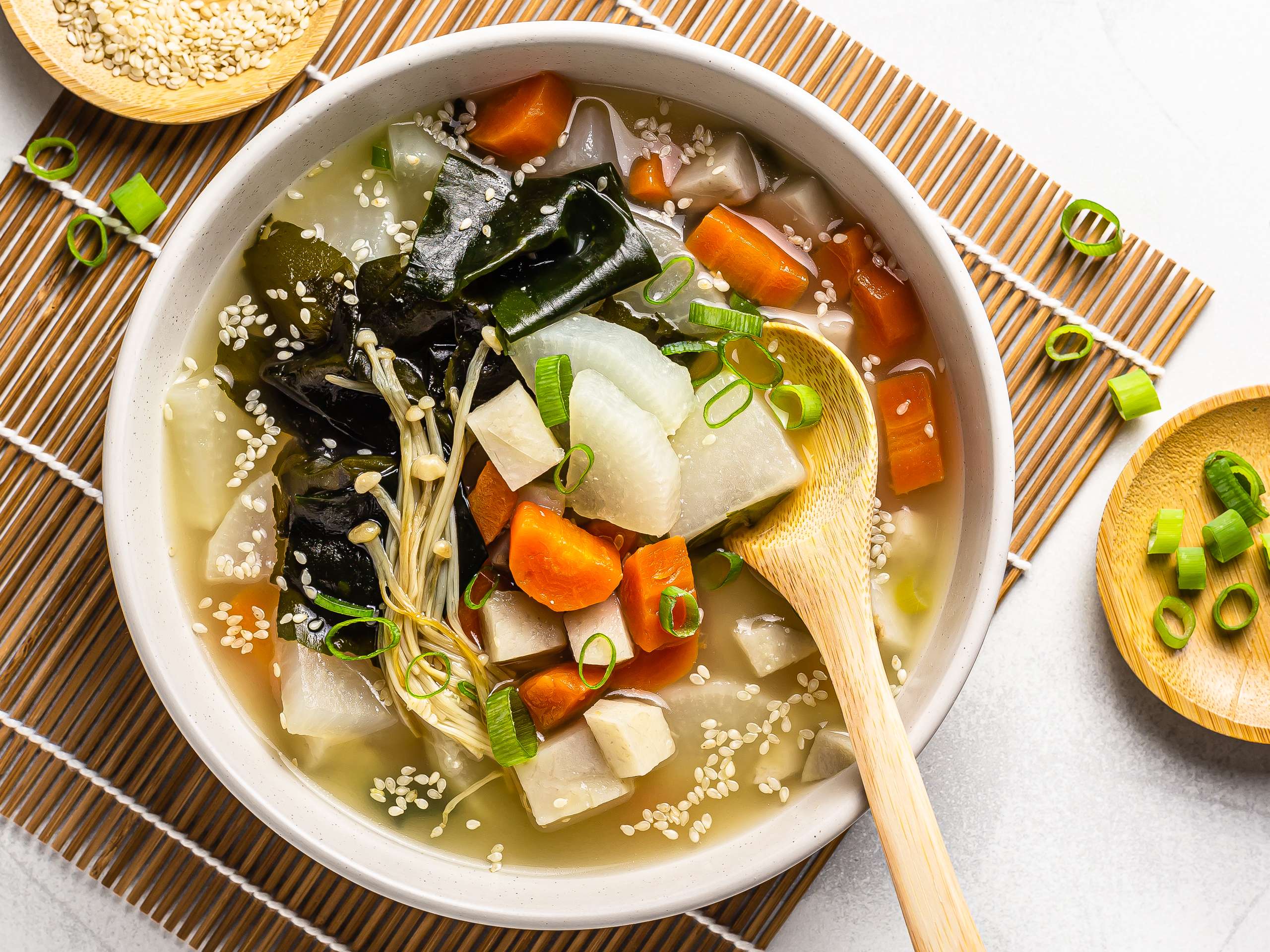Do you love miso? Did you know that not all miso soups are vegan? Today we’re making a rich miso soup with daikon and other great root vegetables. We topped it with sautéed enoki mushrooms for the ultimate umami flavor. And our miso soup is vegan!
Why aren’t all miso soups vegan, you ask? There are two essential components of miso soups: the broth – called dashi (出汁) – and the miso paste. The miso paste is vegan as it is a by-product of soy. But not all dashi broth is vegan: some contain a fish-derived product called bonito flakes (katsuobushi, 鰹節). Well, below we show you how to make a vegan dashi broth from scratch using only plant-based ingredients.
Miso soups are often consumed as a small appetizer before starting the actual feast. That’s great, but we wanted to make a soup that would stand on its own as a main course. That’s why our soup contains delicious root vegetables that ensure a good balance of nutrients and taste.
We searched for vegetables that are common in Japanese cuisine as we wanted to preserve the authenticity of this famous dish. In the end we picked daikon, taro root, carrots, Enoki mushroomsAnd spring onions. If you can’t find enoki mushrooms, you can use king oyster mushrooms or shiitake mushrooms and cut them into strips.
We loved using these veggies in our miso soup, especially the daikon and taro root. They made this classic dish so much tastier and more filling. If you like it as much as we do, there’s good news: Daikon is so big you’ll have enough left over for another round!
Overall, a large bowl of this daikon miso soup will do you 24% RDI for fibers, 10% RDI of carbohydrates, 9% RDI of fats In only 200 calories. A solid meal and the ultimate comfort soup bursting with umami flavor.
frequently asked Questions
What is miso soup made of?
Miso soup is a traditional Japanese dish that is often served as an appetizer at the start of a meal.
The classic recipe consists of dashi broth combined with miso paste.
Dashi broth is the main ingredient in miso soup. It is often prepared by simmering kombu and bonito flakes in hot water.
Kombu, or seaweed, is an edible seaweed that’s popular in East Asian cuisine, and you can find it whole sheets or cut into pieces. When making miso soup, add the kombu to cold water, bring to a simmer and strain the liquid.
Bonito flakes, also known as katsuobushi, are shavings of fermented, preserved fish. They are placed in the hot water, left to steep for a few minutes, and then removed.
Finally, the miso paste is dissolved in some hot broth and then added to the dashi broth before serving.
The result is a rich yet simple soup with a unique umami flavor.
Is miso soup vegan?
Not all traditional Japanese miso soup recipes are vegan, as some contain fish.
Because the dashi broth that forms the basis of miso soup is often prepared with bonito flakes. bonito flakes, or katsuobushi, are shavings of dried fish (either tuna or Bonito).
To make miso soup vegan, you can simply omit the bonito flakes and replace the umami flavor with mushrooms.
We used enoki mushrooms in our daikon stew recipe, but feel free to use other varieties like shiitake or king oyster mushrooms.
What is the best type of miso paste for miso soup?
Miso paste is made from soybeans that are fermented with salt and koji (a type of mushroom).[1].
Miso comes in three varieties:
You can use any of these to make miso soup, so it’s down to personal preference. White miso paste is the lightest and mildest of the three as it ferments the shortest. Red miso paste, on the other hand, has the strongest flavor due to its longer fermentation time.
We used white miso paste.

